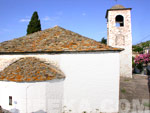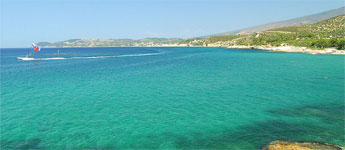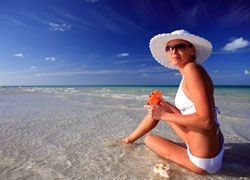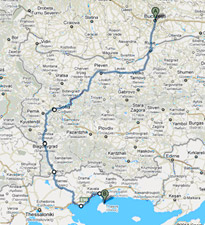About Thassos Island
Thassos, "the emerald island", is situated in the gulf of Kavala, in the northern part of the Aegean Sea and it's the closest to the continental Greece (8 km). Thassos is not far from Keramoti and the estuary of the Nestos River. At its widest part, the island is 22km from east to west and 26 km long from north to south. It has a circumference of about 100 km, being smaller than Rhodes and larger than Samothrace. There is a main road that encircles the island following the coastline and smaller roads that lead to the mountain settlements.
Its coastline is rocky eastwards and westwards and sandy northwards and southwards. Thassos is a mountainous island. The highest peak is Ipsarion (about 1.127 m high), which is easily accessible due to the forest roads.
Thassos is covered by thick forests of pine trees, fir trees, oak trees, and plane trees. Its forests occupy approximately the 9\10 of the island's surface, and olive trees grow all along its coastline. The pine-trees reach the seashores and their timber consists one of the main sources of income for the Thassians.
The island's climate is mild and healthy. During summer months, with few exceptions, the weather is warm and in winter it is not too cold. Hippocrates, who has been considered since the ancient years "the father of Medicine" left us valuable inscriptions on the Thasian climate. In one of his books he states that in Thassos "Generally winter resembles spring". And so it remains until today. The average annual temperature is 17.2 o Cand the average summer temperature (July) is 23.4.
Thassos' underground is rich and the island was known from the ancient years for its minerals. The island is known for its snow white marble, which is the whitest marble in the whole world.
Thassos has been inhabited since prehistoric times. Neolithic tools similar to those discovered in Troy , Limnos and Samothraki have been found at various sites on the island. Thassos is first mentioned by Herodotus, the father of history. He says that the island took its name from Thassos, the first inhabitant of the island. According to the ancient Greek mythology the first person known to have come to the island was Thassos in search of his sister Europe, who had been abducted by Zeus. He was enchanted by the wonderful climate and the luxuriant vegetation of the island and as he could not return home without Europe, he gave up and settled here on the island that bears his name since then.
Greeks arrived on the island about the 7 th century BC from Paros. Beautiful sculptures and ceramics were also found from this period. By the 6 th century AD the inhabitants had become numerous and colonies belonging to Thassos were being established on the mainland of Macedonia and Thrace.
Today, there about 18000 Thassians which are living in more than 31 villages and settlements in Thassos. The main occupations of the inhabitants of Thassos, besides tourism, are related to quarrying, beekeeping, fishing and pottery. Moreover, Thassians produce olive oil, ouzo and wine. Actually, Thassos is well known for its snow white marble, its olive oil, honey and wine. The Thasian wine is among the best wines of Greece. The Queen of Egypt (Cleopatra) sent ships every year to take the Thasian wine to Egypt. It was said that the ancient gods of Mount Olympus would only drink the wines from Thasos.
The capital of the island is Limenas or Thassos. Since ancient years Limenas has been the most important town of the island. Limenas is the administrative and commercial center of Thassos. There are many hotels here, restaurants, shops, banks, phone company and post office buildings and the bus station. The town of Thassos also presents a great interest from an archeological point of view, so much for the remaining ruins that were unearthed, as for the rich findings that are exhibited in its museum. The Archeological Museum of Thassos is one of the richest museums in Northern Greece. Here you can admire a collection of unique antiquities dating from the 7 th century BC to the 7 th century AD.
The Archaeological museum of Thassos is not the only museum you can visit on this island. Of great interest are the folklore museums and The Museum of Polygnotos Vagis in Potamia. Interesting archaeological areas can be seen in Alyki (the ancient and Byzantine ruins) and Kastro(here the bones of the dead are still kept in a chapel).
Thassos island has beautiful beaches all around the coast. Some of them are organized and crowded, while others are pretty queiet. All the beaches are incredibly beautiful, with crystal clear water and fine sand. The most beautiful beaches on the island are GoldenBeach and ParadiseBeach (nudist). Other beaches that are worth visited are Alyki, Skala Prinos, TripitiBeach, Psili Ammos or PotosBeach.

in Theologos
The inhabitants of the island have kept the traditions inherited from generation to generation. One of the old habits still retained are the festivals that take place in favor of the saints. Thassians are very religious people and they have built many churches and monasteries on the island. Some of the most important would be: St. Panteleimonas Monastery in Kazaviti, Archangelos Monasterynear Alyki, Church of Panaghia = VirginMary in the town of Panagia, Church of Saint Anargyri in Kallirachi or the churches St. Demetrios and St. Paraskevi in Theologos.
The island of Thassos , apart from being a place with a fascinating history and rare natural beauty, can also offer visitors everything they need for a perfect and truly unforgettable stay. There are plenty of hotels on the island, as well as bungalows, villas and camping areas. Moreover, the residents of the island offer accommodation in their own homes.
















